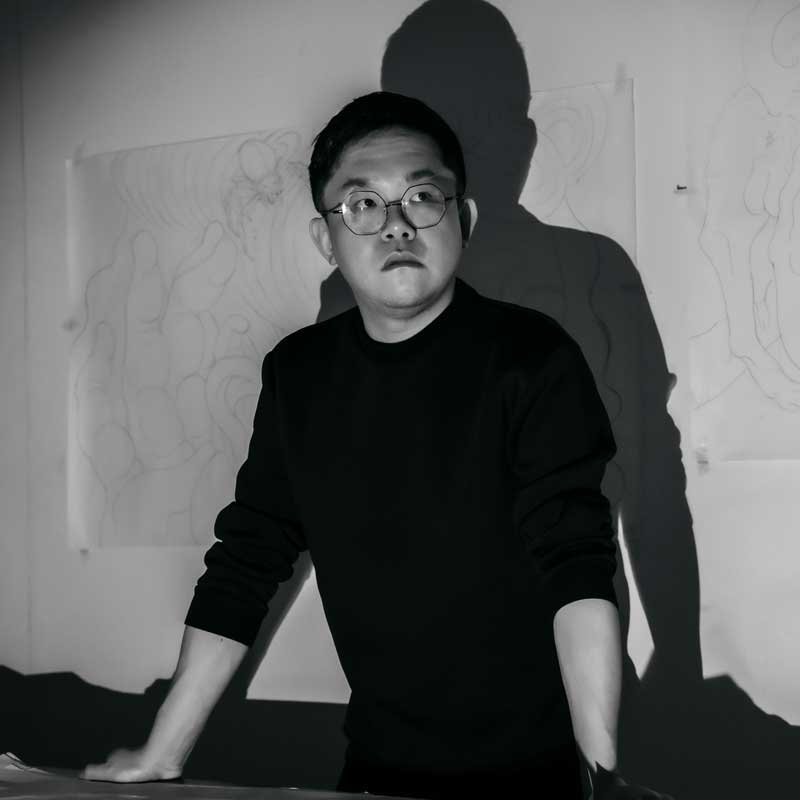1987年出生于台湾南投县,现工作于台北。他2009年毕业于国立台湾师范大学,获学士学位,2013年毕业于国立台北艺术大学,获硕士学位。硕士在读期间,曾建颖系统性地研究并掌握了胶彩画的媒材与技法。胶彩画以动物胶为媒介,混合天然矿物粉末,如石青、孔雀石、青金石、锡、钴、以及朱砂等,用细毛笔在纸、绢、金箔或石膏上作画。毕业后,曾建颖开始探究并追溯胶彩画技法在东亚宗教绘画及宫廷绘画中的历史起源。2017年,他获得亚洲文化协会的奖学金,之后赴美国纽约、印尼日惹、中国西、北部等地区研究早期佛教艺术,如洛阳的龙门石窟、甘肃天水的麦积山石窟、敦煌莫高窟以及大同的云冈石窟等。
曾建颖艺术实践的核心是通过探索宗教图像学与宗教视觉体验,对规范性进行批判性的审视与反思。运用自身对“酷儿”的敏感性,他通过将宗教图像中神圣与亵渎的颠倒,挑战甚至违背固有观念中好/坏,美/丑,正常/不正常,以及受欢迎/不受欢迎之间的界限与定义。在他对“酷儿”的艺术诠释中,身体、欺骗、肉体、恋物、牺牲、束缚、死亡和腐烂都被神圣化。曾建颖的“酷儿”敏感性不单只是对后现代批判理论的一种个人诠释,他的“非规范性”观念也源于他对佛教哲学中二元结构的非现实性以及道教相对主义思想的研习与探究。因此,曾建颖的艺术创作可以被视为一种探索——如何运用佛教和道教传统艺术实践和审美体验,为“非规范”或“酷儿”等后现代概念赋予一种体验形式。
曾建颖对宗教图像的兴趣并非仅限于亚洲的素材,同时也囊括了与早期佛教艺术在材料与技法上有许多共同之处的拜占庭圣像画。公元 3 世纪通过丝绸之路传入中国的犍陀罗佛教艺术本身就融合了北印度宗教艺术与公元前 4 世纪亚历山大带到中亚的古典希腊艺术造型。因此,拜占庭基督教艺术与中亚佛教艺术在技法与视觉上有诸多相似之处。曾建颖运用这些古代艺术的相似性创造了一种后现代的、跨国性的宗教图像——融合了基督教、佛教、欧洲及亚洲等宗教艺术元素——并以此来探寻“酷儿”的后现代、跨国性的艺术审美。
曾建颖的作品曾在台湾及海外重要博物馆及艺术机构展出,其中包括:国立台湾美术馆,台中(2020、2017、2015);高雄市立美术馆,高雄(2014、2009);国立台北艺术大学,台北(2013、2011);及东海大学艺术中心,台中(2011)等。重要收藏包括:国立台湾师范大学,台北;国立台湾美术馆,台中;及白兔美术馆,悉尼,澳大利亚。
Born in 1987 in Nantou County, Taiwan and currently works in Taipei. He graduated in 2009 with a BFA from National Taiwan Normal University and in 2013 with an MFA from Taipei National University of the Arts. During his MFA studies, Tseng methodically researched and mastered the materials and methods of jiaocai and Nihonga painting in which mineral pigments such as azurite, malachite, lapis lazuli, lead, cobalt and cinnabar are mixed with animal glue and applied with a fine brush on paper, silk, metal foil or plaster. After graduating, Tseng began to investigate the historical origins of this traditional painting method in East Asian religious and court painting and was awarded an Individual Fellowship by the Asian Cultural Council in 2017 through which he traveled to New York; Yogyakarta, Indonesia; and Northern and Western China where he researched the early Buddhist religious art at the Longmen Grottoes in Luoyang, the Maijishan Grottoes in Tianshui, the Mogao Caves in Dunhuang and the Yungang Caves in Datong.
Central to Tseng’s artistic project is his exploration of religious iconography and religious visual experience in an interrogation of normativity. Using a personally-inflected “queer” sensibility, Tseng inverts or transgresses received notions of normal/abnormal, good/bad, beautiful/ugly, desirable/undesirable using the religious iconography of the sacred and sacrilegious. In his aesthetic rendering of the “queer,” body, artifice, flesh, fetish, sacrifice, bondage, death and decay are made sacred. Tseng’s “queer” sensibility, however, is more than a personal interpretation of post-modern critical theory as his notion of the non-normative draws as well from his investigations of Buddhist philosophy—specifically, the non-reality of dualistic constructions—and Taoism—namely, the radical relativism of thinkers such as Zhuangzi. His artistic project, thus, can be seen as an exploration of how historical Buddhist and Taoist artistic practice and aesthetic experience can be repurposed to give experiential form to our post-modern notion of the non-normative or the “queer.”
Tseng’s interest in religious iconography extends beyond his proximal Asian sources and includes Byzantine icon painting which shares many of the same materials and techniques seen in early Buddhist art. The Buddhist art of Gandhara, which arrives in China in the 3rd Century via the Silk Road is itself an admixture of the religious art of Northern India with classical Greek forms brought to Central Asia by Alexander in the 4rd Century B.C. Because of this, the technical and visual similarities between Byzantine Christian and Central Asian Buddhist art can be striking and Tseng exploits these pre-modern similarities to create a post-modern, trans-national religious iconography—part Christian, part Buddhist, part European, part Asian—in pursuit of a post-modern, trans-national aesthetic of the “queer.”
Tseng Chien-Ying’s artwork has been exhibited at the National Taiwan Museum of Fine Arts, Taichung (2020, 2017, 2015), Kaohsiung Museum of Fine Arts, Kaohsiung (2014, 2009), Taipei National University of Art, Taipei (2013, 2011), and the Tunghai University Art Gallery, Taichung (2011). His works are included in the permanent collections of National Taiwan Normal University, Taipei, Taiwan; the National Taiwan Museum of Fine Arts, Taichung, Taiwan; and the White Rabbit Collection, Sydney, Australia.


